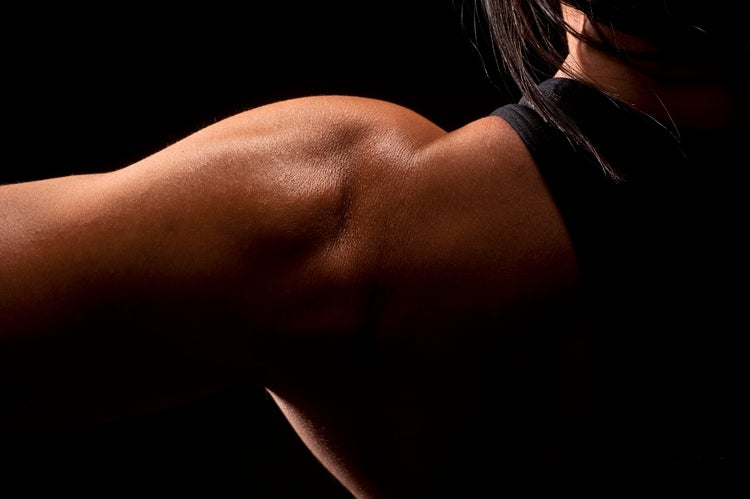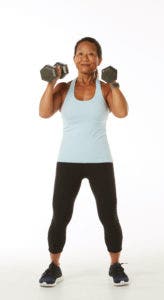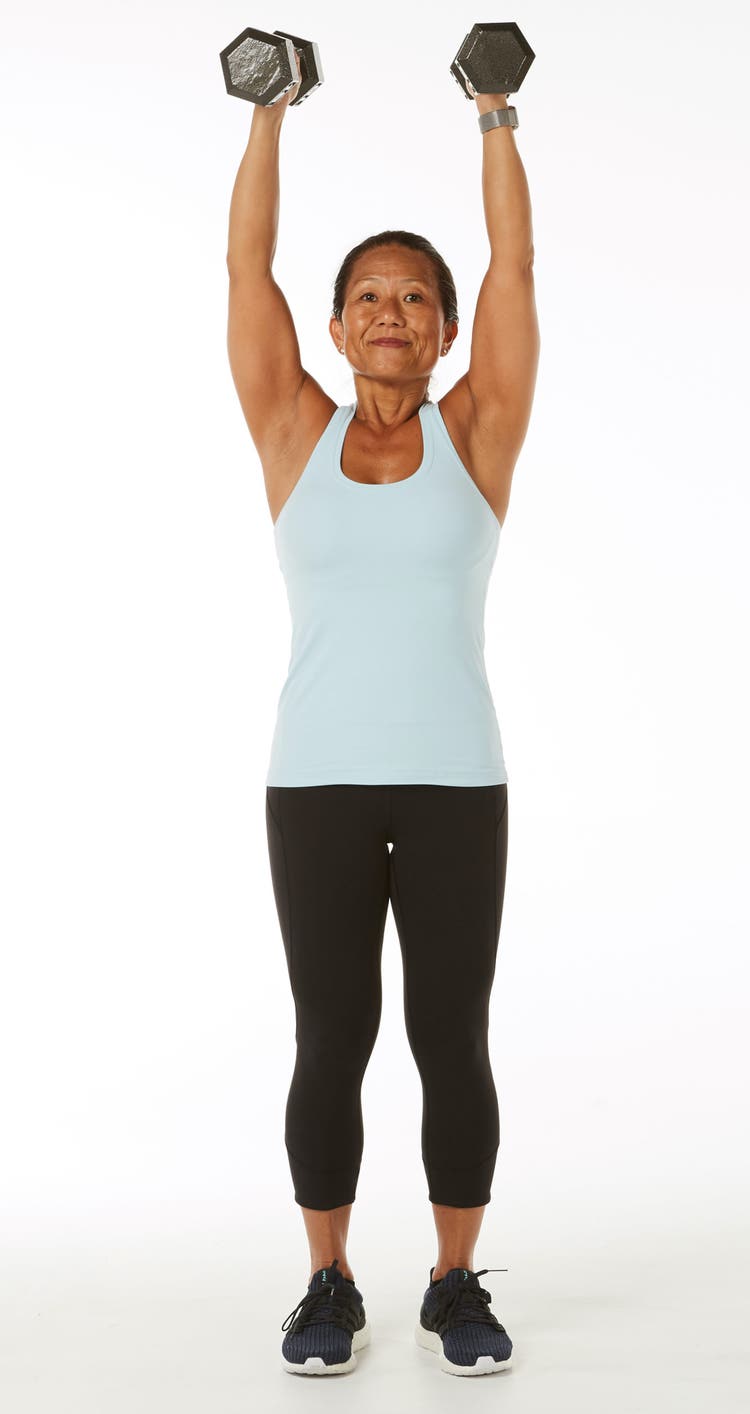Hacking the Shoulder Press

Have you ever experienced pain when doing overhead presses on shoulder day? This hack will help you learn how your shoulders are designed to function so that you can build strong, good- looking shoulders without any discomfort. Most of the exercises that you select for your workouts probably come from the world of bodybuilding. The purpose of bodybuilding is to increase the size and definition of muscles, and the most effective way to do that is to do exercises that focus the force from the movement into a specific segment of muscle tissue. Note: It’s the mechanical forces applied to muscle tissue responsible for initiating the repair process that stimulates growth and improving definition.
Mechanical forces from muscle-isolation exercises can help improve the appearance of a particular muscle. However, most of the joints and muscle tissue in the human body are arranged to work in coordination with other muscles and joints, and if some exercises use only an isolated part of the body as opposed to an entire segment, it could result in an increased risk of injury. The shoulder is an excellent example of a body part in which a number of common exercises isolate specific muscles yet don’t account for how the many joints and muscles are designed to function as a single unit. Many of the shoulder exercises from the bodybuilding community focus on the motion of only one shoulder joint at a time, but there are actually four joints in the shoulder complex designed to function as an integrated unit. If you experience discomfort during your shoulder day, then it’s time to change the way you do overhead presses, which attempt to isolate just one of the many shoulder muscles, and instead train the shoulders as an integrated unit.
The structures of the shoulder
The shoulder comprises four different joints that work together to create a foundation of movement for the arms (Neumann, 2010):
- The sternoclavicular (SC) joint, where one end of the collarbone (clavicle) floats on the chest bone (sternum) and first rib, is a relatively small joint that connects the shoulder and arm directly to the rib cage. (To feel this joint, place your finger on the top of your chest bone as you shrug your shoulders up and down.)
- The acromioclavicular (AC) joint is where the collarbone (clavicle) connects with the shoulder blade (scapula). (To feel this joint, follow your collarbone away from your body to where it connects at the top of your arm.)
- The glenohumeral (GH) joint is the most well-known joint of the shoulder and is where the ball-shaped head of the upper arm bone (humerus) meets the cup-shaped surface of the scapula (the glenoid fossa).
- The scapulothoracic (ST) joint isn’t technically a joint, defined as the point at which two bones connect but is the location where the scapula floats on the surface of the rib cage. Each individual scapula is held in place by 17 muscles responsible for both allowing movement of the scapula to support the humerus as well as creating the stability necessary for optimal posture and to stabilize overhead movements.
The ball-and-socket structure of the GH joint allows a significant range of motion, the ST and SC joints allow motion in a couple of limited directions, and the AC joint allows only a minimal amount of motion, but each joint helps support the motion of the other joints when functioning as an entire unit. The paradox of the shoulder complex is that it needs to have the stability required to prevent unwanted motion while allowing the mobility required for many dynamic movements. (Wilk, Meister & Andrews 2002) If any of the four joints is out of alignment, it will affect the ability of the other joints to perform their requisite functions to allow optimal mobility or provide necessary stability.
Understanding motion of the shoulder
In a healthy, well-functioning shoulder, the cup of the shoulder blade sits at an angle that is about 35 degrees forward from the side of the body (Neumann, 2010). This position of the socket segment of the ball-and-socket of the GH joint means that overhead movements should not be directly to the side of the body—the exact position of the common shoulder press used by the bodybuilding community. Holding the arms directly to the side, at the 3 o’clock and 9 o’clock positions, can isolate the medial head of the deltoids, which is what made this exercise popular for bodybuilders. However, because of how the joints of the shoulder are designed, pressing weight overhead in this position is simply not structurally sound and could create a significant injury.
For optimal alignment of overhead pressing, it is much more advisable to point the elbows in the 10 o’clock and 2 o’clock positions. From this position, when the arms move overhead, the sockets of the scapulae are able to properly rotate under the ball-shaped segments of the arm bones to create optimal stability when the arms push weight overhead.
To get a better understanding of how the shoulder should function in an overhead lift, look to the sport of Olympic weightlifting, specifically the barbell clean-and-jerk. In the catch position of the lift, the bar is resting on the collarbones with the elbows pointing straight ahead. When the athlete jerks (presses) the weight to the overhead position (with the force for the movement coming from the legs), the elbows remain pointing forward, allowing the structures of the shoulder to function as a single unit when the weight is moved and held in the overhead position. The structures of the shoulders would simply not allow this move to be performed if the elbows were pointing to the side in a bodybuilding-style shoulder press. As the barbell moves to the overhead position, the shoulder blades will rotate under the arms to create a stable platform for when the arms go into full lockout at the end of the lift, demonstrating how all four joints function as a single unit.
The hacks

Photo A
To keep your shoulders healthy, happy and strong, it is much better to do your overhead presses with your elbows pointing more forward than sideways. If using dumbbells, hold the weights in front of your body so that your palms are almost facing each other, your triceps (the backs of your upper arms) are resting on your rib cage and your elbows are pointed in the 2 o’clock (right) and 10 o’clock (left) positions (photo A).

Photo B
Keep your spine tall and long as you press both arms overhead (photo B). To create more stability for the shoulders, at the top of the movement, think about pulling your shoulder blades down along the back of your rib cage toward your back pockets. When lowering the weights, don’t just let them fall. Instead, think about pulling your elbows back down toward your rib cage, which will help recruit the large latissimus dorsi muscles of your back to support the movement. An additional hack is to perform this exercise from a standing position (as opposed to seated on a bench), which can help recruit the glutes and other core muscles to create more strength and stability throughout your entire body.
If you’ve been experiencing any discomfort when doing overhead presses, this hack could help you develop optimal joint mechanics to reduce or alleviate that discomfort. Start with a lighter weight than you’re used to in order to learn the new joint position. But don’t worry, as your shoulders adjust to the new range of motion, the strength will come quickly, resulting in shoulders that are healthy, happy and strong and allowing you to train injury-free—as well as rock the tanks and tight tees to show them off.
To learn more about how your body functions, along with the exercises that can help you train in a way to remain injury-free, pick up a copy of “Smarter Workouts: The Science of Exercise Made Simple,” (Human Kinetics, December 2019).
Photo credit: Juanmonino, Getty Images; Pete McCall